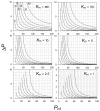Good-Practice Non-Radioactive Assays of Inorganic Pyrophosphatase Activities
- PMID: 33919593
- PMCID: PMC8073611
- DOI: 10.3390/molecules26082356
Good-Practice Non-Radioactive Assays of Inorganic Pyrophosphatase Activities
Abstract
Inorganic pyrophosphatase (PPase) is a ubiquitous enzyme that converts pyrophosphate (PPi) to phosphate and, in this way, controls numerous biosynthetic reactions that produce PPi as a byproduct. PPase activity is generally assayed by measuring the product of the hydrolysis reaction, phosphate. This reaction is reversible, allowing PPi synthesis measurements and making PPase an excellent model enzyme for the study of phosphoanhydride bond formation. Here we summarize our long-time experience in measuring PPase activity and overview three types of the assay that are found most useful for (a) low-substrate continuous monitoring of PPi hydrolysis, (b) continuous and fixed-time measurements of PPi synthesis, and (c) high-throughput procedure for screening purposes. The assays are based on the color reactions between phosphomolybdic acid and triphenylmethane dyes or use a coupled ATP sulfurylase/luciferase enzyme assay. We also provide procedures to estimate initial velocity from the product formation curve and calculate the assay medium's composition, whose components are involved in multiple equilibria.
Keywords: ATP sulfurylase; initial velocity; luciferase; malachite green; methyl green; phosphate assay; pyrophosphate assay; pyrophosphate complexes.
Conflict of interest statement
The authors declare no conflict of interest.
Figures








Similar articles
-
ATP sulfurylase-dependent assays for inorganic pyrophosphate: applications to determining the equilibrium constant and reverse direction kinetics of the pyrophosphatase reaction, magnesium binding to orthophosphate, and unknown concentrations of pyrophosphate.Anal Biochem. 1986 Sep;157(2):385-95. doi: 10.1016/0003-2697(86)90642-1. Anal Biochem. 1986. PMID: 3022616
-
Regulation of pyrophosphate levels by H+-PPase is central for proper resumption of early plant development.Plant Signal Behav. 2012 Jan;7(1):38-42. doi: 10.4161/psb.7.1.18573. Plant Signal Behav. 2012. PMID: 22301965 Free PMC article.
-
Real-time colorimetric assay of inorganic pyrophosphatase activity based on reversibly competitive coordination of Cu2+ between cysteine and pyrophosphate ion.Anal Chem. 2013 Oct 1;85(19):9409-15. doi: 10.1021/ac402524e. Epub 2013 Sep 18. Anal Chem. 2013. PMID: 24016028
-
Biochemical, Structural and Physiological Characteristics of Vacuolar H+-Pyrophosphatase.Plant Cell Physiol. 2018 Jul 1;59(7):1300-1308. doi: 10.1093/pcp/pcy054. Plant Cell Physiol. 2018. PMID: 29534212 Review.
-
Plant proton pumping pyrophosphatase: the potential for its pyrophosphate synthesis activity to modulate plant growth.Plant Biol (Stuttg). 2019 Nov;21(6):989-996. doi: 10.1111/plb.13007. Epub 2019 Jun 5. Plant Biol (Stuttg). 2019. PMID: 31081197 Review.
Cited by
-
Thermophilic Inorganic Pyrophosphatase Ton1914 from Thermococcus onnurineus NA1 Removes the Inhibitory Effect of Pyrophosphate.Int J Mol Sci. 2022 Oct 22;23(21):12735. doi: 10.3390/ijms232112735. Int J Mol Sci. 2022. PMID: 36361526 Free PMC article.
-
Catalytic Asymmetry in Homodimeric H+-Pumping Membrane Pyrophosphatase Demonstrated by Non-Hydrolyzable Pyrophosphate Analogs.Int J Mol Sci. 2021 Sep 10;22(18):9820. doi: 10.3390/ijms22189820. Int J Mol Sci. 2021. PMID: 34575984 Free PMC article.
-
Functional and structural asymmetry suggest a unifying principle for catalysis in membrane-bound pyrophosphatases.EMBO Rep. 2024 Feb;25(2):853-875. doi: 10.1038/s44319-023-00037-x. Epub 2024 Jan 5. EMBO Rep. 2024. PMID: 38182815 Free PMC article.
-
The Mechanism of Energy Coupling in H+/Na+-Pumping Membrane Pyrophosphatase-Possibilities and Probabilities.Int J Mol Sci. 2022 Aug 22;23(16):9504. doi: 10.3390/ijms23169504. Int J Mol Sci. 2022. PMID: 36012762 Free PMC article. Review.
-
Pre-steady-state kinetics and solvent isotope effects support the "billiard-type" transport mechanism in Na+ -translocating pyrophosphatase.Protein Sci. 2022 Sep;31(9):e4394. doi: 10.1002/pro.4394. Protein Sci. 2022. PMID: 36040263 Free PMC article.
References
-
- Heinonen J.K. Biological Role of Inorganic Pyrophosphate. Kluwer Academic Publishers; London, UK: 2001.
-
- Scholz-Starke J., Primo C., Yang J., Kandel R., Gaxiola R.A., Hirschi K.D. The flip side of the Arabidopsis type I proton-pumping pyrophosphatase (AVP1): Using a transmembrane H+ gradient to synthesize pyrophosphate. J. Biol Chem. 2019;294:1290–1299. doi: 10.1074/jbc.RA118.006315. - DOI - PMC - PubMed
Publication types
MeSH terms
Substances
Grants and funding
LinkOut - more resources
Full Text Sources
Other Literature Sources
Miscellaneous

